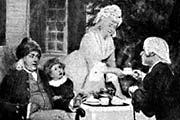Meriwether Lewis' Philadelphia
 |
| Philadelphia was well known for its social gatherings among the city’s intellectual and cultural leaders. Image © 2002 www.clipart.com. |
By 1800 more than 70,000 people lived in and around Philadelphia. It was the largest city in the United States. Its economy was booming. Farmland was expensive and becoming harder to find, so many young people from the countryside moved to Philadelphia. European immigrants continued to arrive at the port of Philadelphia. Many chose to stay in the city. They came from England, Ireland, Germany, the Netherlands, France, and other Western European countries. However most people in Philadelphia in 1800 had been born in North America. Most Philadelphia Indians were long gone. They had died from disease or were driven out by the settlers.
Many scientists, politicians, and intellectuals also called Philadelphia home. Philadelphia was the capital of the United States from 1790 to 1800. Even after the capital moved to Washington, many writers, scientists, and thinkers stayed. Jefferson had met some of them while serving on the Continental Congress in 1776. He came to know them even better as secretary of state from 1789-1793.
Philadelphia was the center of scientific learning at this time. Institutions such as the American Philosophical Society earned this reputation for the city. Benjamin Franklin started the society in 1743. It included scientists and leading political figures committed to developing science knowledge. Jefferson himself joined the society in 1780. He served as its president. He even wrote about fossils found in his native Virginia.
The city's thriving shipbuilding trade and important role in building and supplying ships for the Revolutionary War also led to a U.S. first in Philadelphia. In 1801 the first U.S. Naval Shipyard opened on the Delaware River.
Philadelphia also had many schools, universities, cultural institutions , and the first hospital in America. Scientists there were creating new ways to learn. They relied on exacting observation and analysis.
On the western edge of Philadelphia were two wondrous locations, Bartram's Garden and The Woodlands. They exemplify the scientific enlightenment in Philadelphia at the time. Bartram's Garden and The Woodlands were both created to preserve and study nature.
With all that Philadelphia had to offer, Jefferson had little doubt that it was the best place for Lewis to receive his scientific training.
< previous | next > | 


